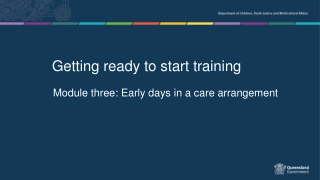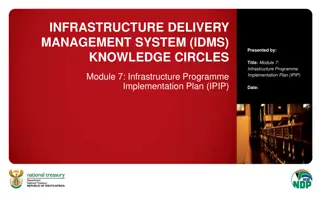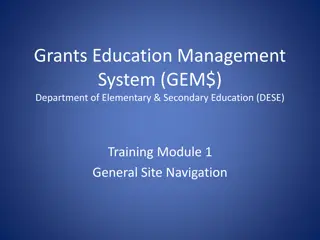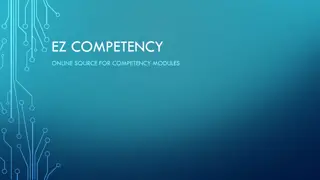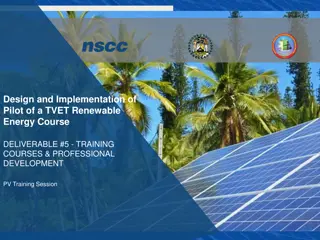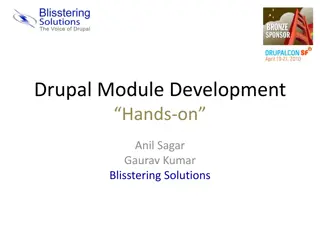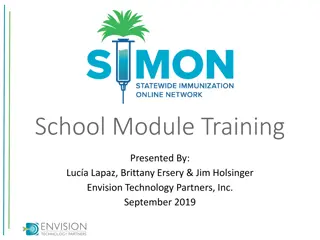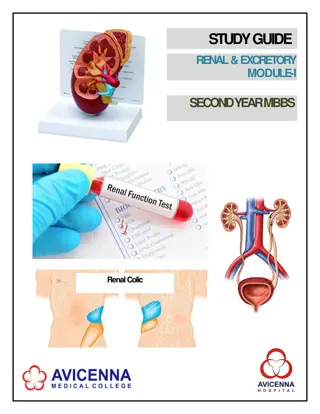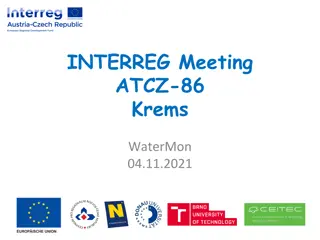
Academic Vertical Alignment Training and Renewal
Explore the AVATAR program focused on enhancing career and college readiness through vertical alignment initiatives, critical conversations, and assessment strategies. Discover the roles and goals of AVATAR in bridging the transition from high school to college.
Uploaded on | 0 Views
Download Presentation

Please find below an Image/Link to download the presentation.
The content on the website is provided AS IS for your information and personal use only. It may not be sold, licensed, or shared on other websites without obtaining consent from the author. If you encounter any issues during the download, it is possible that the publisher has removed the file from their server.
You are allowed to download the files provided on this website for personal or commercial use, subject to the condition that they are used lawfully. All files are the property of their respective owners.
The content on the website is provided AS IS for your information and personal use only. It may not be sold, licensed, or shared on other websites without obtaining consent from the author.
E N D
Presentation Transcript
1 Module 1 http://untavatar.org
2 Overview AVATAR: Academic Vertical Alignment Training and Renewal http://untavatar.org
3 An African Proverb It takes a village to raise a child. http://untavatar.org
4 School/College as a Village Counselors/ Advisers Teachers Parents Students Campus Staff Administrators Community http://untavatar.org
5 Statewide Regional Partnerships http://untavatar.org
6 This Module will introduce 1. 2. 3. 4. 5. Rationale Partners and Roles Critical Conversations Use of Data Action Plans
7 Rationale http://untavatar.org
8 AVATAR Goals Expand awareness of career and college readiness and vertical alignment. Create regional vertical alignment initiatives. Implement strategies to close regional academic course and expectation gaps. Identify processes to assess and celebrate regional progress. Share best practices statewide. 1. 2. 3. 4. 5. http://untavatar.org
9 AVATAR Rationale The AVATAR Process is built on Critical Conversations between secondary and postsecondary leaders and educators. The conversation is structured and facilitated in order to achieve course vertical alignment in content, cross-disciplinary, and college preparatory skills. http://untavatar.org
10 Team Member Introductions Activity: Go Round Robin and introduce the team members. What institution and campus do you represent? What is your role with students? Share an experience about the transition of a student from high school to college. http://untavatar.org
11 Partners and Roles
12 http://untavatar.org WHO IS INVOLVED IN AVATAR? http://untavatar.org
13 S c a f f o l d i n g S c a f f o l d i n g S t u d e n t S t u d e n t S u c c e s s S u c c e s s AVATAR is a Partnership of Regional Leaders From The Following Institutions http://untavatar.org
14 AVATAR Partners Partnerships: Leaders and educators representing regional independent school districts, two- and four-year institutions of higher education, P-16 councils, and education service centers arecommitted to vertical alignment to support students college and career readiness and success. http://untavatar.org
15 Partnership Benefits Build capacity to improve alignment between regional secondary and postsecondary courses and curriculum Strengthen regional secondary and postsecondary commitment to and capacity for college preparedness and success for students http://untavatar.org
16 AVATAR Partners and Team Members Are committed to higher education access and success for all students Understand content course knowledge and skills Utilize research-based instructional strategies Demonstrate strong communication and leadership skills Are effective team players Are flexible able to deal with ambiguity http://untavatar.org
17 AVATAR Partners Roles and Responsibilities Education Service Center (ESC) or Others Who Serve as Facilitators/Coordinators Convene a vertical alignment team (VAT) Expand or create a regional shared college and career readiness foundation/understanding among the partnership and team Support the P-16 council and the partnership in securing and reviewing their regional college and career readiness student data Facilitate the vertical alignment critical conversations Design and implement with the partnership their vertical alignment action plan http://untavatar.org
18 AVATAR Partners Roles and Responsibilities Independent School District (ISD) Identify campus or district leaders to participate and support vertical alignment partnership and team Identify and support discipline specific teachers and leaders to participate in the vertical alignment process Review and discuss course and instructional practices based on the VAT s work Expand and/or develop a campus or district vertical alignment plan for next academic year http://untavatar.org
19 AVATAR Partners Roles and Responsibilities Postsecondary Education: Two- and Four-Year Institutions of Higher Education General/Core Education Leaders and Faculty Identify campus, system, or district level leaders who are responsible for core or general education courses to participate in and support the vertical alignment partnership and team Identify and support discipline specific faculty and leaders to participate in the vertical alignment process Develop or review course syllabi and based on the VAT s study of vertical alignment Expand and/or develop a campus or district vertical alignment plan for the next academic year http://untavatar.org
20 AVATAR Partners Roles and Responsibilities P-16 Council Provide regional college and career readiness student data and prepare the regional data PowerPoint Serve as the recorder for the regional vertical alignment team and partnership Receive and respond to periodic reports on the progress of the partnership http://untavatar.org
21 AVATAR Vertical Alignment Teams Vertical Alignment Teams (VATs): Educators and leaders representing regional ISDs, two- and four-year institutions of higher education, P-16 councils, and ESCs are committed to addressing discipline specific course and instructional alignment needs to create environments where students can make successful transitions between and among regional educational systems. http://untavatar.org
22 Critical Conversations http://untavatar.org
23 Starting Points for Critical Conversations (What can you add?) Heard from High School Students Heard from College Students It s OK. My mom was not good in math either. Dr. Jones, how can I get some extra credit to make up for my low test score? Chemistry? Not for me! I m planning to be a doctor! Textbook? Why? I never used one in high school! Study? Not today! I have to work to keep my car running! Me, failing English? No one ever called me in to tell me! http://untavatar.org
24 Critical Conversations Pyramid Post-Secondary Graduate Career Ready Secondary Graduate College/Career Ready Impact of Developmental Education and Texas Success Initiative Student Success Assessments Dual Credit, Early College High Schools Student Support Services Dual Credit, Early College High Schools Student Support Services Educational Policies & Practices Classroom Instruction, Textbooks Grading, etc. Discipline Specific Course Curriculum Educational Policies & Practices Classroom Instruction, Textbooks Grading, etc. Discipline Reference Course Profiles College & Career Readiness Standards Texas Essential Knowledge and Skills http://untavatar.org
25 Use of Data http://untavatar.org
26 Sources of Data Used by VATs The Texas Higher Education Coordinating Board (THECB) produces an annual profile for each public college. Data are available that show what colleges students attend by high school and how they perform as well as admission, transfer, performance, and completion data for each college. The Texas Education Agency (TEA) produces annually a Texas Academic Performance Report (TAPR) for each campus, district, and region, and for the state. These reports provide student achievement and college readiness data by gender, ethnicity, and socioeconomic status. http://untavatar.org
27 Examples of Use of Data by VATS Region 20 Problem: Region 20 formed VAT s for ELAR and math but found from TEA student achievement data that math was a higher priority concern. Solution: The Partnership continued the math VAT and engaged the ELAR teachers in a supportive study of uses of language in teaching math. This strengthened the work of the math VAT. Region 16 Problem: When the VAT examined THECB data, they found the high school on the VAT did not feed the 2-year college. Solution: The Regional P-16 Council invited the 2-year college fed by the active high school and the high school to which the active 2- year college was a feeder to join the VAT. http://untavatar.org
Sample THECB Data: Transfer Students to UT San Antonio from most common feeders, 2012 Developmental Education prior to Transfer Alamo CCD Total N <2.0 2.0- 2.49 2.5- 2.99 3.0- 3.49 >3.5 Enroll Fall 2010 235 Unk No Developmental Education Vista Alamo CCD Palo A Alamo CCS SA SW TX Jr Coll. N <2.0 95 2.0- 2.4 9 8 2.5- 2.9 9 13 3.0- 3.4 9 11 >3. 5 39 Unk 11 Enrol l Fall 10 38 434 310 53 63 49 72 46 9 5 0 390 260 26 46 6 60 8 48 61 5 44 1 1 0 217 21 51 6 Data show that for this cohort, transfer students to UTSA from SW TX JC were least likely to have been enrolled in Developmental Education and those from Alamo College San Antonio were least likely to earn a failing grade. http://untavatar.org
29 The AVATAR Process Creates and builds relationships through ongoing critical conversations Uses regional data to make alignment decisions Develops shared understanding of college and career readiness and success for students Identifies and implements intentional actions Evaluates, sustains, and shares vertical alignment work http://untavatar.org
30 Action Plans http://untavatar.org
31 Sample Action Plans Region 12 After study of vertical alignment inn ELAR and mathematics, both VATs selected craft materials focused on demonstrated areas of student need and employed a lesson study process to develop common understandings and instructional processes. Region 6 After study of vertical alignment in writing, an ELAR VAT developed the guidebook for alignment of high school and college writing, now available statewide. http://untavatar.org
32 Sample Action Plans for CPC College Preparatory Courses After offering of a College Preparatory Course, develop an action plan around one or more of the following: Better student performance Stronger evidence of college readiness Better alignment to the next college course in the core curriculum College Preparatory Courses Many VATS in 2014-15 will develop College Preparatory Courses in ELA or mathematics. Study of alignment issues will lead to actions planned for the next offering such as better alignment of tests and assignments to course objectives. http://untavatar.org
33 Steps toward AVATAR Outcomes Identify key leaders and educators who make up a regional pipeline needed for students to be college and career ready and successful 1. Establish shared regional college and career readiness foundation/understandings 2. Use regional data to guide decision-making 3. Design and implement a vertical alignment action plan which will include critical conversations around specific courses needed for students to make academic progress 4. Design and implement a sustainability plan 5. Prepare students for college and career success 6. http://untavatar.org
34 Rationale Partners and Roles Critical Conversations Recap Use of Data Action Plans http://untavatar.org
35 Questions http://untavatar.org
36 Find an inspirational quote to share http://untavatar.org


